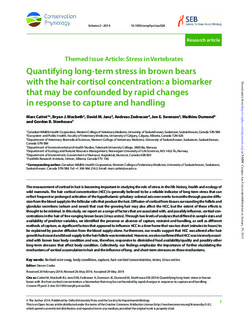| dc.description.abstract | The measurement of cortisol in hair is becoming important in studying the role of stress in the life history, health and ecology of wild mammals. The hair cortisol concentration (HCC) is generally believed to be a reliable indicator of long-term stress that can reflect frequent or prolonged activation of the hypothalamic–pituitary–adrenal axis over weeks to months through passive diffusion from the blood supply to the follicular cells that produce the hair. Diffusion of cortisol from tissues surrounding the follicle and glandular secretions (sebum and sweat) that coat the growing hair may also affect the HCC, but the extent of these effects is thought to be minimal. In this study, we report on a range of factors that are associated with, and possibly influence, cortisol concentrations in the hair of free-ranging brown bears (Ursus arctos). Through two levels of analyses that differed in sample sizes and availability of predictor variables, we identified the presence or absence of capture, restraint and handling, as well as different methods of capture, as significant factors that appeared to influence HCC in a time frame that was too short (minutes to hours) to be explained by passive diffusion from the blood supply alone. Furthermore, our results suggest that HCC was altered after hair growth had ceased and blood supply to the hair follicle was terminated. However, we also confirmed that HCC was inversely associated with brown bear body condition and was, therefore, responsive to diminished food availability/quality and possibly other long-term stressors that affect body condition. Collectively, our findings emphasize the importance of further elucidating the mechanisms of cortisol accumulation in hair and the influence of long- and short-term stressors on these mechanisms. | |

